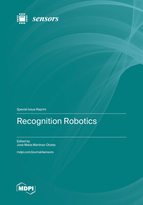Recognition Robotics
A special issue of Sensors (ISSN 1424-8220). This special issue belongs to the section "Sensors and Robotics".
Deadline for manuscript submissions: closed (30 April 2023) | Viewed by 35879
Special Issue Editor
Interests: machine learning; computer vision; 3D vision; deep learning; video action recognition
Special Issues, Collections and Topics in MDPI journals
Special Issue Information
Dear Colleagues,
Perception of the environment is an essential skill for robotic applications that interact with their surroundings. Along with perception often comes the ability to recognize objects, people, or dynamic situations. This skill is of paramount importance in many use cases, from industrial to social robotics. This Special Issue addresses fundamental or applied research in object recognition, activity recognition, and people recognition, focusing on robotic applications.
Dr. José María Martínez-Otzeta
Guest Editor
Manuscript Submission Information
Manuscripts should be submitted online at www.mdpi.com by registering and logging in to this website. Once you are registered, click here to go to the submission form. Manuscripts can be submitted until the deadline. All submissions that pass pre-check are peer-reviewed. Accepted papers will be published continuously in the journal (as soon as accepted) and will be listed together on the special issue website. Research articles, review articles as well as short communications are invited. For planned papers, a title and short abstract (about 100 words) can be sent to the Editorial Office for announcement on this website.
Submitted manuscripts should not have been published previously, nor be under consideration for publication elsewhere (except conference proceedings papers). All manuscripts are thoroughly refereed through a single-blind peer-review process. A guide for authors and other relevant information for submission of manuscripts is available on the Instructions for Authors page. Sensors is an international peer-reviewed open access semimonthly journal published by MDPI.
Please visit the Instructions for Authors page before submitting a manuscript. The Article Processing Charge (APC) for publication in this open access journal is 2600 CHF (Swiss Francs). Submitted papers should be well formatted and use good English. Authors may use MDPI's English editing service prior to publication or during author revisions.
Keywords
- recognition robotics
- industrial robotics
- social robotics
- object recognition
- people recognition
- activity recognition







